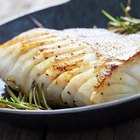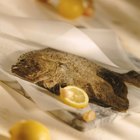
Fish and chips is one of the world's great fast foods, a classic on par with hamburgers, pizza, falafel sandwiches and tacos. The combination of crisp, golden batter and tender, moist fish is alluring, and the smell of frying fish can draw aficionados from miles around. Traditionally, beef tallow was the preferred deep-frying fat; it was later replaced by solid shortenings. Now, to avoid hydrogenated oils and trans fats, restaurants and home cooks have shifted to vegetable oils.
Deep Frying Basics
Fish is much more delicate than red meats or poultry, with shorter, tenderer muscle fibers and relatively little internal fat. That means it's physically fragile during cooking, and easily can become dry and leathery if it's cooked at high temperatures. Cooks counter those tendencies by coating the fish with breading or batter. It's the coating that comes into contact with the hot fat, so the fish itself doesn't develop a leathery, overcooked layer. The coating also forms a seal around the fillets, so the fish essentially cooks in its own superheated steam. This helps keep it moist and delicate.
The Oil
Deep-fried fish shouldn't be greasy if it's done right. The secret to good deep frying is temperature. Most fish is best when cooked at temperatures of 360 to 380 degrees Fahrenheit, although smaller pieces can sometimes be cooked at higher temperatures. The best oils to use are those with a high "smoke point." That's the temperature at which the oil begins to break down, generating off flavors and potentially carcinogenic free radicals. The best oils for deep frying have smoke points of 400 degrees F and above, so they're not near their limit at normal cooking temperatures.
Choosing an Oil
Some oils, such as avocado oil, tolerate very high temperatures but are too expensive for this kind of use. Most olive oils have a distinctive flavor that doesn't necessarily complement the fish, and the smoke points of many olive oils are too low for fish. But olive oils labeled "pomace" or "extra-light" have a suitably high smoke point, and are refined enough to have no distinct olive flavor. Safflower oil and soybean oil have exceptionally high smoke points and neutral flavors. Mid-oleic and high-oleic sunflower oils work well for frying fish, and tend not to break down under high temperatures and repeated use. Grapeseed oil and corn oil are also acceptable options.
A Few Tips
Preparing non-greasy fried fish depends on good technique, as much as your oil. Use lots of oil, so the temperature of it doesn't drop dramatically when you add the fish. A temperature drop slows the cooking and promotes absorption of the oil. If your fryer has a small oil capacity, cook just one or two pieces of fish at a time. It helps to set your thermostat to a higher temperature, so the temperature drop doesn't inhibit cooking as much. If you don't have a fryer, use a deep pot with a frying or candy thermometer inserted into the oil. Open-pot deep frying is dangerous on a gas stove, and requires constant attention even on an electric coil, so shoo any kids and pets out of the kitchen and be sure your fire extinguisher is close to hand.
Related Articles

What Kind of Oil Should I Use to ...

The Benefits of Tuna & Omega-3 Oil

Cooking Oils With Low Smell
Is It Safe to Reuse Your Cooking Oil to ...

What Is Expeller Pressed Canola Oil?

Substitutes for Groundnut Oil in Cooking

Sesame & Peanut Oil for Cooking

How Do I Pan Fry Fresh Fish With a ...

How to Fry Fish That Was Frozen

Substitutes for Walnut Oil

Can You Grease a Pan With Canola Oil?

Does Deep-Frying Vegetables Rob Them of ...

Which Olive Oil Is Best to Fry With?

What Are the Benefits of Krill Oil on ...
Does Cooking Oil Go Bad?
Cooking With Camellia Oil

The Advantages of Wok Cooking

How to Roast Whole Flounder

Can Doughnuts Be Deep Fried in Olive ...
How Long Can You Keep and Reuse Peanut ...
References
- On Food and Cooking: The Science and Lore of the Ktichen; Harold McGee
- Cooking for Engineers: Smoke Points of Various Fats
- The Washington Post: Where There's Smoke, There's a Fryer
- The New York Times: Is It Time for an Oil Change in the Kitchen?
Writer Bio
Fred Decker is a trained chef and prolific freelance writer. In previous careers, he sold insurance and mutual funds, and was a longtime retailer. He was educated at Memorial University of Newfoundland and the Northern Alberta Institute of Technology. His articles have appeared on numerous home and garden sites including GoneOutdoors, TheNest and eHow.
Photo Credits
Jupiterimages/Photos.com/Getty Images